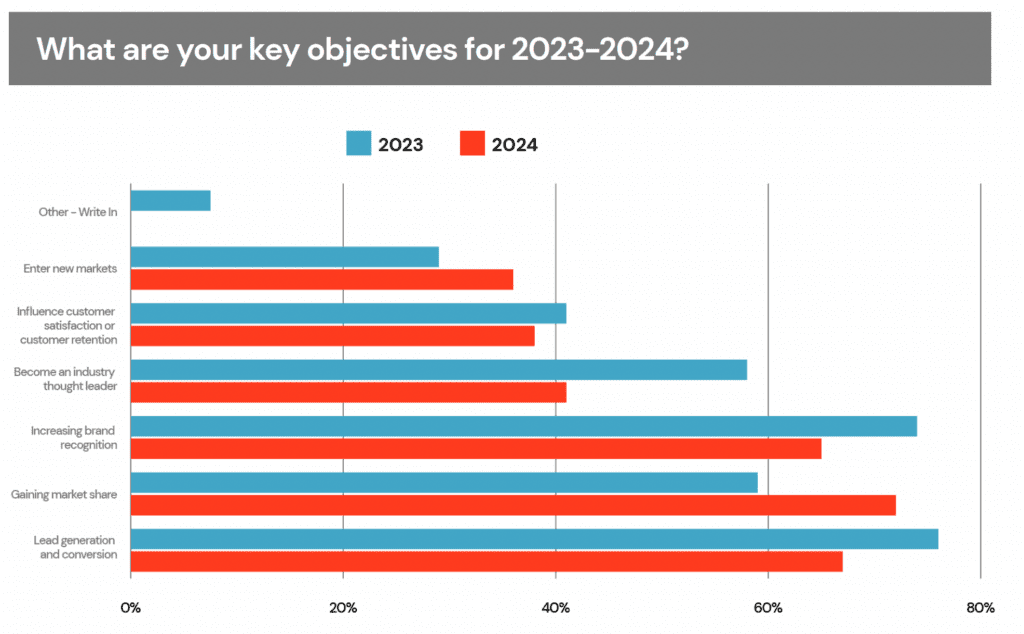
Supply Chain Marketers' Top 3 Objectives in 2024 and How to Achieve Them
2024 is here! As a supply chain marketer, are you prepared for the year ahead?
There’s no doubt you’ve already set your goals for the year, so we’re here to help make sure you achieve those objectives and give you a chance to see what your peers are working toward.
In this new blog, we outline the top three marketing objectives for the supply chain industry as determined by our 2024 Supply Chain Marketing Industry Outlook and Trends Report. Of course, we wouldn’t leave you hanging by just pointing out the goals, we also provide tips for achieving them!
Key Marketing Priorities for the Year
In the dynamic landscape of supply chain marketing, professionals are gearing up for a transformative year ahead. Based on our recent survey, we found the top three marketing objectives for 2024 remain gaining market share, lead generation, and increasing brand awareness. Interestingly, while the top 3 objectives are the same as our 2023 survey, the order has shifted. Gaining market share climbed two spots to #1, while lead generation fell to #2, and increasing brand awareness shifted down one spot to #3.

Objective 1: Gaining Market Share
Market share is the percentage of the total market that a company controls for its products and services. Supply chain companies use this metric as an indicator of their company’s profitability and success. By shifting into the number one spot, we can infer that supply chain marketers are now focused on strengthening their existing market standing rather than chasing raw lead volume growth.
Gaining marketing share is not always easy, but it is doable. Here are some ideas to achieve this goal.
Tips:
- Strategic Positioning: Evaluate your current market position and identify areas for improvement. Develop strategies to differentiate your brand and offerings from competitors.
- Customer Retention: Invest in customer loyalty programs and personalized experiences to retain existing customers. Conduct personal outreach and ensure you are staying on top of any issues or concerns that may arise. Satisfied customers not only contribute to revenue but also serve as brand advocates.
- Partnerships and Collaborations: Explore strategic partnerships within the supply chain ecosystem to enhance your market presence. Collaborative efforts can lead to shared success and expanded market influence. This can include co-op marketing campaigns, hosting or joining webinars with industry peers, joint trade show/event appearances, speaking opportunities with a strategic partner, case studies, or whitepapers.
Objective 2: Lead Generation
Although lead generation has shifted to the second spot, it remains a critical objective closely tied to revenue. HubSpot found that, across the board, marketing leaders are focused on “increasing revenue and sales,” which is highlighted by lead generation efforts. They also noted the importance of tailoring lead generation strategies to the unique needs of each business. As such, here are a few ideas to boost your lead generation efforts and, as a result, profitability.
Tips:
- Optimized Content: Test and optimize calls-to-action (CTAs) on all content, including landing pages, blogs, email marketing, social media, etc. This method of A/B testing will help improve conversion rates and identify what resonates best with your target audience. Once you identify what works, stick with it, and keep hitting your audience with the right content and CTAs.
- Irresistible Offers: Create compelling and tailored offers to capture the attention of potential leads. Consider promotions, discounts, or exclusive content to incentivize engagement.
- Diversify Marketing Channels: Continually test new marketing platforms, such as podcasting, TikTok, webinars, and content syndication tools. This will help reach audiences in new and interesting ways. Stay adaptable and be open to exploring emerging channels that align with your target demographic.
Objective 3: Increasing Brand Awareness
While moving down to the third spot, increasing brand awareness remains crucial for supply chain marketers. A strong brand presence contributes to customer trust and loyalty. To elevate brand awareness, try the following:
Tips:
- Consistent Brand Messaging: Ensure a cohesive and consistent brand message across all marketing channels. There should be consistency in the look, message, and feeling that it all portrays. Consistency builds brand recognition and fosters a strong connection with the audience.
- Content Marketing: Develop a robust content marketing strategy that educates, informs, and entertains your target audience. Valuable content establishes your brand as an authority in the industry and puts you top of mind for speaking engagements and guest appearances on webinars and podcasts. Also, be sure to pitch your thought leadership content to industry media.
- Social Media Engagement: Actively engage with your audience on social media platforms. Encourage user-generated content, participate in conversations, and showcase the human side of your brand to create a memorable and relatable identity.
Now, Are You Ready to Tackle Your 2024 Objectives?
With January almost behind us, you should also be fully underway in your efforts to reach your goals. By aligning strategies with these top objectives and implementing our suggested tips, your company will successfully gain market share, generate leads, and increase brand awareness.
For more information about these objectives and other industry trends, check out the 2024 Supply Chain Marketing Industry Outlook and Trends Report. In it, you’ll find your peers’ top pain points, marketing metrics to track, budget data, and more.
Interested in the Full Report?
Click the button below to access more information about the survey.


